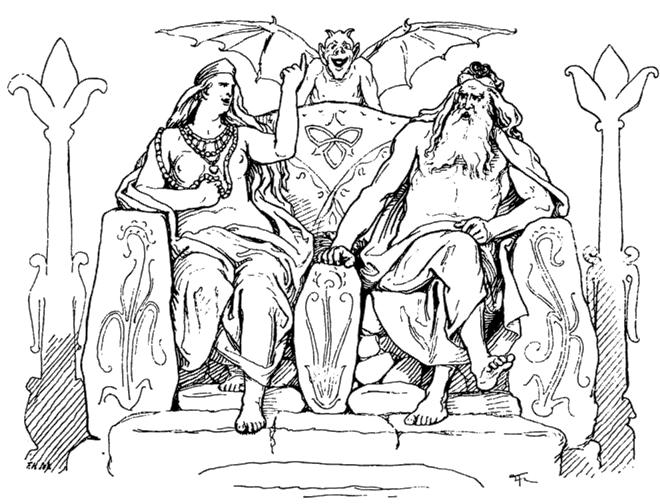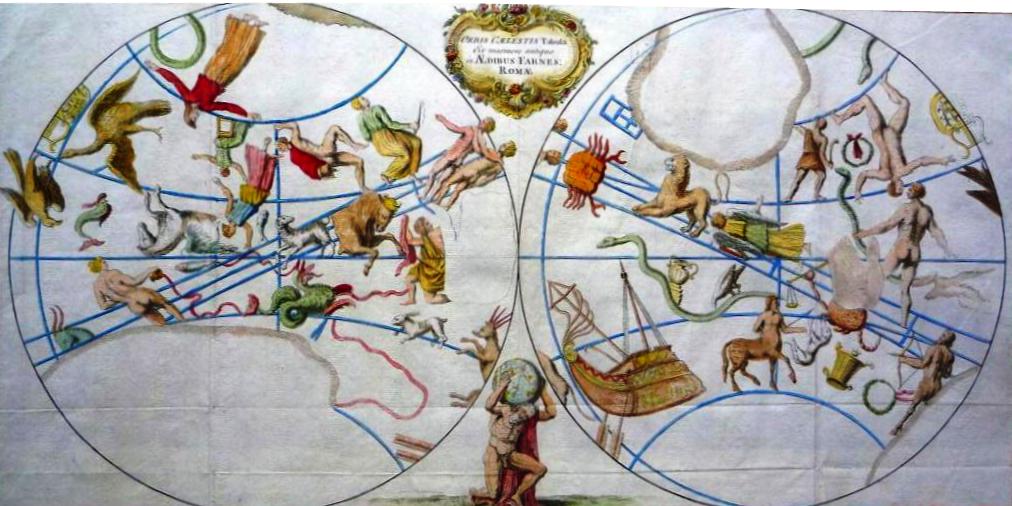The High-Seat of the Gods
by Peter Krüger
©2013
[Germanic Astronomy]

Odin and Frigg on Hlidskjalf
Lorenz Frølich (1845)
According to the
prose introduction of Grímnismál, Frigg and Odin are said to sit on Hliðskjálf
and watch over all the worlds:
Óðinn ok Frigg sátu í Hliðskjálfu ok
sáu um heima alla.
The very same place appears in the
opening of Skírnismál, but now it is Freyr who takes a seat on Hliðskjálf, and
looks out over all the worlds:
Freyr, sonr Njarðar, hafði einn dag
setzt í Hliðskjálf, ok sá um heima alla.
This episode is mentioned in the
Gylfaginning with similar words:
| Þat var einn dag, at Freyr hafði gengit í Hliðskjálf ok sá of heima alla. | "One day when Frey had gone into Hlidskjalf, and was looking out upon all the worlds." |
In his Gylfaginning, Snorri locates this place in Asgard:
| Þar er einn staðr, er Hliðskjálf heitir, ok þá er Óðinn settist þar í hásæti, þá sá hann of alla heima ok hvers manns athæfi ok vissi alla hluti, þá er hann sá. | "There is one abode called Hlidskjálf, and when Allfather (Odin) sat in the high-seat there, he looked out over the whole world and saw every man's acts, and knew all things which he saw." |
Snorri connects this place later on with two other places called Himinbjörg and Valaskjálf:
| Þar er enn sá staðr, er Himinbjörg heita. Sá stendr á himins enda við brúarsporð, þar er Bifröst kemr til himins. Þar er enn mikill staðr, er Valaskjálf heitir. Þann stað á Óðinn. Þann gerðu goðin ok þökðu skíru silfri, ok þar er Hliðskjálfin í þessum sal, þat hásæti, er svá heitir, ok þá er Alföðr sitr í því sæti, þá sér hann of alla heima. | "Furthermore, there is a dwelling, by name Himinbjorg, which stands at the end of heaven, where the Bifrost-bridge is united with heaven. And there is a great dwelling called Valaskjalf, which belongs to Odin. The gods made it and thatched it with, sheer silver. In this hall is the high-seat, which is called Hlidskjalf, and when Alfather sits in this seat, he sees over all the world." |
For a last time it is mentioned in Gylfaginning in the description of the capture of Loki:
| Óðinn sét ór Hliðskjálfinni, hvar hann var. | "Odin had seen from Hlidskjalf where Loki kept himself. " |
Hliðskjálf is also mentioned in
Hrafnagaldur Odins, again in connection with ‘heimur’, world:
| Galdur gólu, göndum riðu, Rögnir og Reginn að ranni heimis; hlustar Óðinn Hliðskjálfu í; leit braut vera langa vegu. | "Sorcery they sang, wolves they rode, Rögnir and Reginn, against the world's house; Óðinn listens in Hliðskjálf; watched the travellers' distant journey." |

Cassiopeia, the Seated Woman
But where could this place be from which it is possible to see ‘um heima alla’? To look over all lands one would climb to the top of a mountain. In astronomical context I assume that this must be a place in the region near the very north of heaven, near to the polar star but at least in the region of the never setting constellations. The choice is therefore not very big: Ursa Major (the big dipper), Ursa Minor, Draco, Kepheus, Cassiopeia, parts of Perseus and Cygnus.
Once again I would like
to take the help of Aratus Phainomena. And indeed we find a throne in
the very same region of the sky:
[248] Her two feet (=Andromeda)
will guide thee to her bridegroom, Perseus, over whose shoulder they are
forever carried. But he moves in the North a taller form than the
others. His right hand is stretched toward the throne of the mother of
his bride (=Cassiopeia), and, as if pursuing that which lies before his
feet, he greatly strides, dust-stained, in the heaven of Zeus.
[634] The hapless
Cassiopeia herself too hastes after the figure of her child
(=Andromeda). No longer in seemly wise does she shine upon her throne,
feet and knees withal, but she headlong plunges like a diver, parted at
the knees; for not scatheless was she to rival Doris and Panope.
Indeed we find on all classical
illustrations of the celestial map Cassiopeia sitting on a throne. The
throne touches on celestial globes like the Farnese globe the arctic
circle in the very north of heaven (see picture below). As the
constellation Cassiopeia is near the North Star, it is moving relatively
fast in the sky so that it is very appropriate to say that from this
throne all the worlds can be seen. Whether Valaskjálf is identical to
Hlíðskjálf or another place in the circumpolar region requires a further
investigation.
